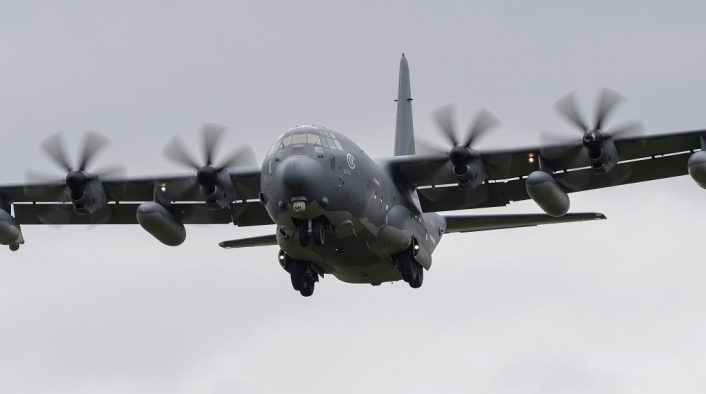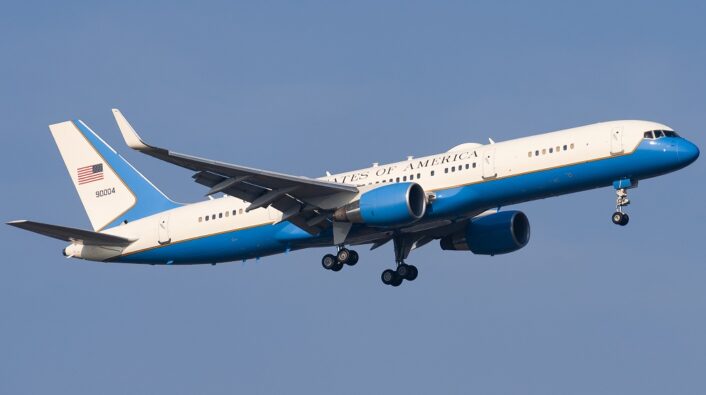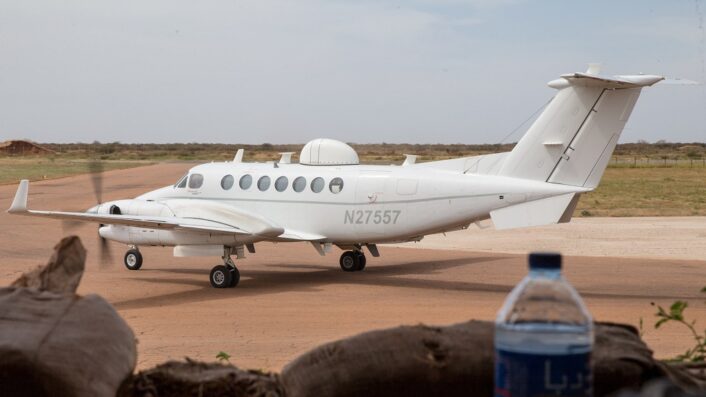The move is supposed to mitigate the operational security threats posed by open-source ADS-B systems.
Earlier this year, we reported about the U.S. Air Force Air Mobility Command making a drastic change to its fleet of cargo and tanker aircraft, removing all identification markings, including tail numbers, tail flashes, unit markings and the iconic U.S. Air Force writing usually found on the fuselage. The decision, which left the aircraft wearing a plain grey livery with a small US flag on the tail and low-visibility USAF roundels, was said to be due to operational security (OPSEC) reasons.

Since then, various AMC aircraft have been sighted without markings, including multiple C-130s and KC-135s. It now appears that other aircraft are losing their markings, as C-32A executive transport jets and the secretive C-32B Gatekeeper personnel transport planes, both military variants of the Boeing 757, have been caught without serial numbers.
オハSAM139
98-0002
R/W36↘︎#RJTY pic.twitter.com/1rJTEkJQjT
— すぷりんぐまん (@HAKONE_kuma) July 14, 2023
Last month, a C-32A was photographed first at Phoenix airport and later while landing at Yokota Air Base in Japan and the lack of the serial number painted on the vertical tail, just below the US flag, immediately caught the eye of plane spotters. Even if the serial number was removed, spotters were still able to find it, together with the flight’s callsign, by using open-source flight tracking.
The same happened at least since April with the C-32B, which was photographed with the serial number, usually painted near the rearmost passenger door, replaced by a small US flag. Again, flight trackers were still able to determine through open-source data the identity of what would otherwise be a “ghost aircraft”, with its completely plain white livery.
C-32B 00-9001 as ” COORS76 ” departing KAFW yesterday.
Thanks to @KSOSINT, @JANN_IIS, @norb420, @BackyardSpotter and @adriancmp__ for radio and info. 🤝#aviation #aviationphotography #photography #Dallas #AvGeek pic.twitter.com/bpHfq2kGku
— Centennial State Spotter ( TX ) (@SR_Planespotter) June 8, 2023
The C-32A is used for the U.S. Vice-President, the Secretary of State and the First Lady or Gentleman, but in some rare occasions it can get the role of Air Force One and transport the President where the VC-25 is not a suitable option. Its highly visible livery makes it immediately noticeable wherever it goes, so the removal of the serial number might not appear that useful.

The C-32B, on the other hand, is used to transport U.S. State Department Foreign Emergency Support Teams (FEST), which deploy in response to terrorism incidents around the world, but they may also fly in support of shadowy CIA Special Activities, according to some sources. In this case, the “anonymization” of the aircraft might make more sense, as special operations assets could get moved without letting everyone know US forces are in town, but a completely white aircraft without markings equally attracts a lot of attention.
The C-37s VIP jets also appear to be among the aircraft seeing their serial code removed, with the C-37B used by the U.S. Air Force Chief of Staff, Gen. Charles Q. Brown, Jr., photographed without its tail number. The C-37A and B models are twin engine, turbofan VIP transport and special airlift aircraft built by Gulfstream Aerospace and usually employed in the transportation of high-ranking government and military officials. While some C-37s sport the classic blue and white livery, some are painted in a more a more discrete white livery, with just a horizontal gold stripe from the note to the tail.
I was already in awe of Gen Charles “CQ” Brown, 22nd Chief of Staff of the United States Air Force, and then he rolled up in the left hand seat having flown himself to RIAT. Perks of my dual role supporting US Visiting Forces in the UK.’ #riat #NoOrdinaryJob #USAF pic.twitter.com/4t2pmb1B2t
— Gp Capt Fred Wigglesworth (@StnCdrRAFMarham) July 13, 2023
While these measures complicated the visual identification of the aircraft, the military is taking steps move around discretely without being immediately identified by plane trackers. Last week, the Joint Special Operations Command released its annual unclassified document identifying technologies that the military might be looking for, a sort of technological wishlist for the defense industry which could develop new products.
Among the products that the command would like to receive from the industry there is, under the Situational Awareness category, an Aircraft Flight Profile Management Database Tool based on big data analysis. The tool is intended to “leverage historical and real-time data, such as the travel histories and details of specific aircraft with correlation to open-source information, social media, and flight reporting”.
With this document, it appears that the military is acknowledging what plane trackers are able to do by using simple Open-Source Intelligence methods and is looking at ways to better blend in the air traffic and hide in plain sight, without getting quickly exposed. The document also includes an example scenario where such a tool might be used:
“SOF seeks to conduct movement of personnel and assets to an area of interest with a reduced profile. When determining if the planned movement is suitable and appropriate, the “Aircraft Fight Profile Management Database Tool” reveals that the aircraft is primarily associated with a distinctly different geographic area. Additionally, “tail watchers” have posted on social media pictures of the aircraft at various airfields. Based on the information available, the commander decides to utilize a different airframe for the mission. With the aircraft in fight, the tool is monitored for any indication of increased scrutiny or mission compromise.”
JSOC aircraft are already quite difficult to identify, since they often fly with civilian liveries and registrations. However, some of them are identified by expert tail watchers using all the tools that are freely available on the web. Given the clandestine nature of many of the missions flown by JSOC, having their identity unveiled on the web might be a serious problem.

The U.S. Senate is also trying to bring the matter to the table, with senators asking the Secretary of Defense to address the situation as soon as possible with a DoD-wide policy to apply the Joint/Interagency-Ground/Air Transponder Operational Risk Reduction tactics, techniques, and procedures (TTPs) that have been developed to prevent tracking of military flights. Here is an extract of the Congressional guidance filed last week:
“The Department of Defense (DOD) has confirmed in briefings that it has developed a number of tactics, techniques, and procedures (TTPs), which it calls Joint/Interagency-Ground/Air Transponder Operational Risk Reduction, that are intended to mitigate the operational security threats posed by third parties tracking DOD aircraft through open source data broadcast by Automatic Dependent Surveillance-Broadcast [ADS-B] transponders. The Department has also confirmed that it has tested these TTPs and that they can be effective against tracking.
Still, the Department acknowledges that the use of these TTPs is not consistently applied for sensitive DOD flights, in part because the decision whether to use the TTPs has been decentralized due to a lack of an overarching DOD policy.
The committee understands there are several software programs that track DOD aircraft, including aircraft DOD uses to transport senior government officials. The software is able to do this because these flights are not using the TTPs, making them readily tracked. Therefore, the committee expects the Secretary of Defense to address this situation by ensuring that a DOD-wide policy for preventing release of such sensitive information is promulgated as soon as possible.”
It’s important to notice that, while these concerns are legitimate for operational missions, some “countermeasures” are already in place. For instance, popular flying tracking websites like Flight Radar 24 and Radar Box already accept requests to hide the identity of some aircraft tracked on the website, showing just few flight data such as speed and altitude and hiding registrations and so on.
At 15,000ft their line of sight is ~240km, meaning the ADSBexchange receivers which tracked them are within 240km of the Strait of Hormuz
Off the coast of the UAE they were in LOS of at least 4 receivers which is how they were geolocated without transmitting exact location data.
— Steffan Watkins (@steffanwatkins) July 18, 2023
Other “countermeasures” are also readily available for the transmitting aircraft, like the Mode S and Mode 5 Identification Friend or Foe (IFF). Although they share the same transmitters, Mode S is more selective than ADS-B about the info it relays, as well as requiring more receivers to triangulate the position, and this way the aircraft might “disappear” from flight tracking websites. The Mode 5 IFF, which is becoming the standard on NATO aircraft, is often referred to as an encrypted military variant of ADS-B: only dedicated receivers can see the aircraft, which at the same time is invisible to flight tracking websites.








